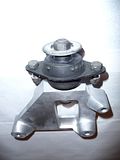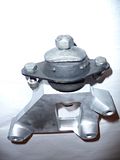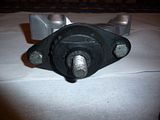Maz wrote:
Pash


....you think too much mate, or maybe not enough !........look at how your Buell works and you may just understand why Erik fitted the D washer convex upwards

Yeah, so, the Buell works by having an engine that hangs from the frame, which is prevented from moving side to side by tie rods. It still has two degrees of freedom, back and forth and up and down. Out of balance is caused by the pistons compressing, the cylinders firing, the acceleration/deceleration of the pistons and rods plus any mass induced out of balance on the crankshaft, this induces an acceleration in these two degrees of freedom as the cylinders at 22.5deg to the vertical.
Is this understanding correct so far?
Now, the inner of the rubber mount is bonded to a metal sleeve which bolts to the engine, and the outer to a plate which bolts to the frame. This rubber gives a rising rate spring and damper effect which is the isolation.
By putting the washer on with the convex side downwards, you get the same spring and damping coefficients up and down and you also have movement fore and aft. Put it the other way up, and you have a higher spring rate downwards and you restrict the fore and aft movement.
Now, lets look at the other things:
1. The D-washer is flat one side, and convex the other. Why go to the complexity of making a washer like that when a flat one would do?
2. The D-washer has a flat edge to prevent clashing with the headstock, the rubber doesn't, this suggests that the washer sits much higher than the rubber.
3. The manual (S1) and parts book (S1 and X1) actually depict the counterbored side facing upwards (however a 2001 manual shows no counterbore and no convex side).
4. Look at the design of the XB mount, the spring/damper effect is the same in both directions.
So, where is my thinking off track?
kevmean wrote:
My X1 is as per picture 2 and is the original factory fitted mount

Not that it makes any difference, Muffin is broken, unloved and forgotten







